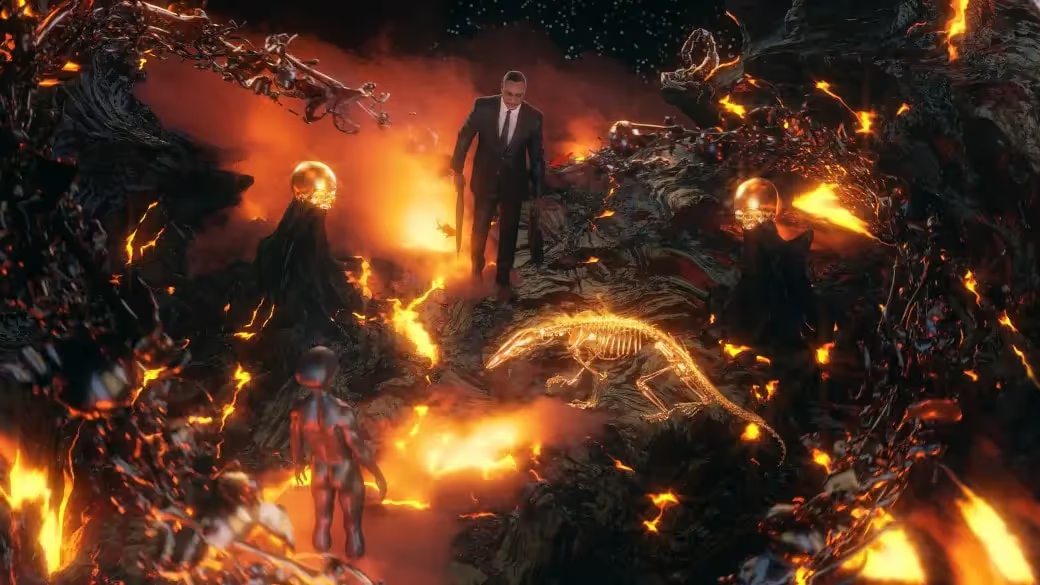
We asked Murat where he draws inspiration from for his artworks. He said he is inspired by nature and everyday events. With an answer like that, you’d think his art would feature forests, landscapes, people at a farmer’s market on a Sunday morning, mundane things.
Murat Sayginer is anything but mundane.
Take for example one of his NFTs on MakersPlace, The Blockchain Fantasy.
It’s a Christopher Nolan-ish animation of what seems like the patterns on an Ethereum coin but could also be buildings or gold bars or staircases or circuit boards. Quick brown foxes sprint across the screen every few seconds. What can be mistaken for a Tyler The Creator-ish album cover appears in the middle once in a while.
Murat’s work can be mesmerizing, trippy, disturbing, meditative, intriguing. Sometimes, all at the same time. View a few of the seamlessly looped 3D animations that Murat has up for sale over at MakersPlace and you’ll know what I’m talking about. Human bones and hellfire swirling around a man in corporate attire. A psychedelic whale bouncing up and down in a living room while a man in beach shorts who looks like he is about to sprint rotates endlessly below. It’s kind of like the surreal works of Salvador Dali but make it internet-y. Every piece of art by Murat is layered, symbolic, multidimensional. It’s as if Murat dipped directly into his subconscious and presented it to us as NFTs.

When asked what the themes in his work are, Murat’s answer is that he doesn’t want to limit how an observer might approach his work. Murat clearly subscribes to the adage “beauty is in the eye of the beholder.” In the case of Murat’s work, so is delirium, transcendence, and deep-seated desires.
Murat pretty much produces only 3D art these days but when he started his career, it wasn’t in 3D. He studied photography and filmmaking in college while doing some freelance work to improve his Photoshop skills. This was around 2007. He started becoming interested in 3D and dropped out of college to pursue this interest. Armed with Greyscalegorilla 3D tutorials, Murat taught himself how to use Cinema 4D.
But even in Murat’s photography output prior to his 3D days, you can already tell that he has a strong and unique point of view. Go to his IG and scroll all the way down (you’ll scroll for some time; Murat is prolific). In all his photos, there’s always a twist, a concept, an enigma, a feeling.
His work on photography has won him awards in the past (his work was selected “IPA Best of Show” in New York in 2008), and he has brought that same award-winning eye to his work in animation. Murat’s animated film The Flying Fish is a collection of animated shorts he has previously created separately and this anthology, too, has earned recognition.
While the short films contained in The Flying Fish may seem disparate, they are all connected in terms of atmosphere and energy. There are recurring symbols and images. It’s as if the films are different dreams but by the same dreamer. The music, too--there’s always a sense of foreboding but also of wonder and even epiphany that underlies the score in all of Murat’s short films. Murat creates the music for most of his animated works.
From photography to 3D to music--Murat is truly a unique talent. You might ask, if he is doing everything for every 3D project of his--from modeling to rendering to animating to scoring--does he even sleep?
He does. When he discovered GarageFarm and the speed that it brought to his process, Murat gained a sense of freedom he didn’t have before. What took days to render now only took hours, and this gave him more time to do other more creative things. Or to rest. “More speed, more sleep,” as Murat would like to say.
Murat strongly recommends using render farms for anyone interested in creating 3D art. For him it’s simple, fast and affordable. He finds it practical, since any artist creating NFTs will definitely deal with thousands of frames to render. Doing that with your own machine can inhibit you from making more art instead. And in the emerging world of NFTs, more art, more money.
If you want to learn more about NFTs (and the role of art in that space), we have an article about its history and development here.
If you are ready to render your 3D project to turn into an NFT or otherwise, get started here.
Murat Sayginer likes to use Cinema 4D, Realflow for fluid simulations, Daz3D for characters, Forrester for trees and landscapes, and Greyscalegorilla for lights and materials.